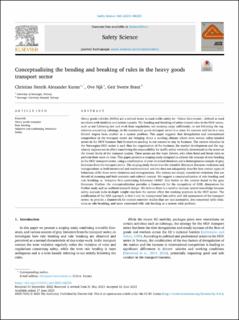| dc.contributor.author | Kuran, Christian Henrik Alexander | |
| dc.contributor.author | Njå, Ove | |
| dc.contributor.author | Braut, Geir Sverre | |
| dc.date.accessioned | 2023-09-14T12:26:45Z | |
| dc.date.available | 2023-09-14T12:26:45Z | |
| dc.date.created | 2023-06-18T13:54:29Z | |
| dc.date.issued | 2023-10 | |
| dc.identifier.citation | Kuran, C.H.A., Njå. O. & Braut, G.S. (2023) Conceptualizing the bending and breaking of rules in the heavy goods transport sector. Safety Science, 166, 106235 | en_US |
| dc.identifier.issn | 0925-7535 | |
| dc.identifier.uri | https://hdl.handle.net/11250/3089491 | |
| dc.description.abstract | Heavy goods vehicles (HGVs) are a critical factor in road traffic safety for “Vision Zero-events”, defined as road accidents with fatalities and serious injuries. The bending and breaking of safety-related rules in the HGV-sector, such as not following rest and work hour regulations, not securing cargo sufficiently, or not following the regulations concerning cabotage, in the commercial goods transport sector is a cause for concern and has in a very limited degree been studied as a system problem. This paper suggests that deregulation and international competition in the transport sector are bringing about a working climate where even serious safety-minded actors in the HGV business find themselves needing to cut corners to stay in business. The current situation in the Norwegian HGV sector is such that the organization of the business, the market development and the regulatory regimes are in effect transferring the responsibility for traffic safety vertically downwards to the actors at the lowest levels of the transport system. These actors are the truck drivers, who often bend and break rules to perform their work on time. This paper presents a scoping study designed to address the concept of rule bending in the HGV transport sector, using a combination of peer reviewed literature and a heterogeneous sample of grey literature from the transport sector. The scoping study shows how the scientific literature discusses violations and transgressions as both intentional and nonintentional acts but does not adequately describe how certain types of behaviour differ from overt violations and transgressions. The actions are simply considered violations that are devoid of meaning and both systemic and cultural context. We suggest a conceptualization of rule bending and rule breaking as “Adaptive Non-conforming Behaviour (ANB)” that builds on the context found in the grey literature. Further, the conceptualization provides a framework for the recognition of ANB, dimensions for further study and an outlined research design. We believe there is a need to increase system knowledge because safety analysis lacks in-depth insight into how the system affect the working practices in the HGV sector. The justification of the ANB approach is that it can be incorporated into safety and risk assessments of the transport sector, to provide a framework for context-sensitive studies that are non-normative, less concerned with violations as rule breaking, and more concerned with rule bending as a system wide problem. | en_US |
| dc.language.iso | eng | en_US |
| dc.publisher | Elsevier Ltd. | en_US |
| dc.rights | Navngivelse 4.0 Internasjonal | * |
| dc.rights.uri | http://creativecommons.org/licenses/by/4.0/deed.no | * |
| dc.subject | samfunnssikkerhet | en_US |
| dc.subject | trafikksikkerhet | en_US |
| dc.title | Conceptualizing the bending and breaking of rules in the heavy goods transport sector | en_US |
| dc.type | Peer reviewed | en_US |
| dc.type | Journal article | en_US |
| dc.description.version | publishedVersion | en_US |
| dc.rights.holder | © 2023 The Author(s). | en_US |
| dc.subject.nsi | VDP::Samfunnsvitenskap: 200 | en_US |
| dc.source.volume | 166 | en_US |
| dc.source.journal | Safety Science | en_US |
| dc.identifier.doi | 10.1016/j.ssci.2023.106235 | |
| dc.identifier.cristin | 2155520 | |
| dc.source.articlenumber | 106235 | en_US |
| cristin.ispublished | true | |
| cristin.fulltext | original | |
| cristin.qualitycode | 2 | |

